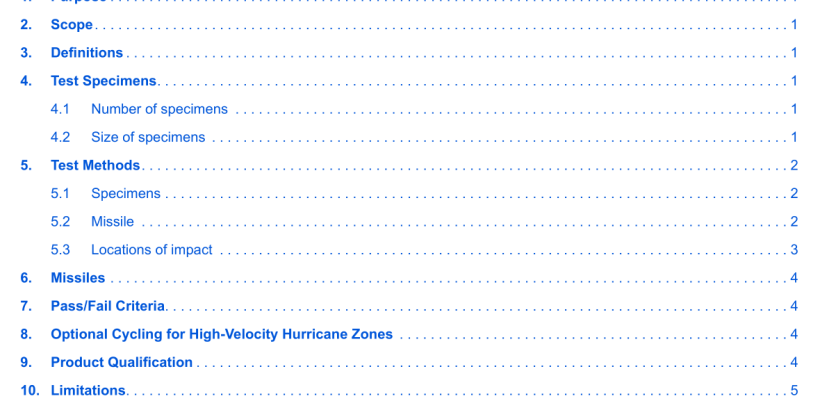ANSI AMCA 540-2013 pdf download.Test Method for Louvers Impacted by Wind Borne Debris
4.1.2 One additional specimen may be submitted for testing should any original submitted specimen described in Section 4.1 fail any portion of the AMCA Standard 540 testing. This is described in Section 9.2. If all specimens pass the AMCA Standard 540, and then some or all of the same specimens are then subjected to Cyclic testing as described in Section 8, and any one specimen fails any portion of the subsequent test(s), then one additional specimen may be submitted to re-test to the subsequent tests as long as the additional specimen frst passes the AMCA Standard 540 tests.
4.2 Size of specimens
The test specimen selected is intended to evaluate the criti- cal failure area of the louver and provide guidance for blade support requirements. The critical failure area for louvers is the connection between the louver blade end and the perim- eter louver frame. Failures in this area result in loose mate- rial that can result in projectiles in high wind events. The most stringent test specimen for this connection is a section where the blade has no additional support between these end connections. Energy from the impact is transferred to the connection with little absorption by blade fexure. This test specimen also provides guidance regarding the maxi- mum unsupported blade length that will not allow the projec- tile to pass through the louver blades. Louvers manufactured with blade spans greater than that of the test specimen shall have blade supports at a spacing that matches the tested specimen blade length. These supports are typically locat- ed behind the blade running perpendicular to the axis of the blade and are attached to the perimeter frame of the louver or to the surrounding building structure. Due to the fact that the test specimen is used to qualify support locations in this way, the manufacturer may wish to test an additional speci- men with a width narrower than desirable support spacing to establish a smaller minimum section width.
4.2.1.1 Horizontal blade
The test specimen shall consist of a single section. The sec- tion width shall be equal to the maximum blade span the manufacturer would supply without providing a blade sup- port plus the added width of the specimen jamb frames. The minimum height of the test specimen shall be 915 mm (36 in.). The test specimen shall also contain a minimum of fve blades. This specimen shall qualify single sections of widths greater than the specimen, provided the manufac- turer supports the louver blades at a spacing equal to the blade length of the specimen. The tested width becomes the minimum section certifed by the impact test. The spec- imen qualifes all single section heights. If the manufactur- er wishes to certify a width narrower than the test specimen, an additional test specimen shall be provided. The minimum height of this narrower test specimen shall also be 915 mm (36 in.), and it shall contain a minimum of fve blades. See Annex A, Figure A.1.
4.2.1.2 Vertical blade
The test specimen shall consist of a single section. The sec- tion height shall be equal to the maximum blade span the manufacturer would supply without providing a blade sup- port plus the added thickness of the specimen head and sill frames. The minimum width of the test specimen shall be 36 inches. The test sample shall also contain a minimum of fve blades. This specimen shall qualify single sections of heights greater than the specimen, provided the manufac- turer supports the louver blades at a spacing equal to the blade length of the specimen. The tested height becomes the minimum section certifed by the impact test. The spec- imen qualifes all single section widths. If the manufactur- er wishes to certify a height less than the test specimen, an additional test specimen shall be provided. The minimum width of this smaller test specimen shall also be 915 mm (36 in.), and it shall contain a minimum of fve blades. See Annex A, Figure A.2.ANSI AMCA 540-2013 pdf download
